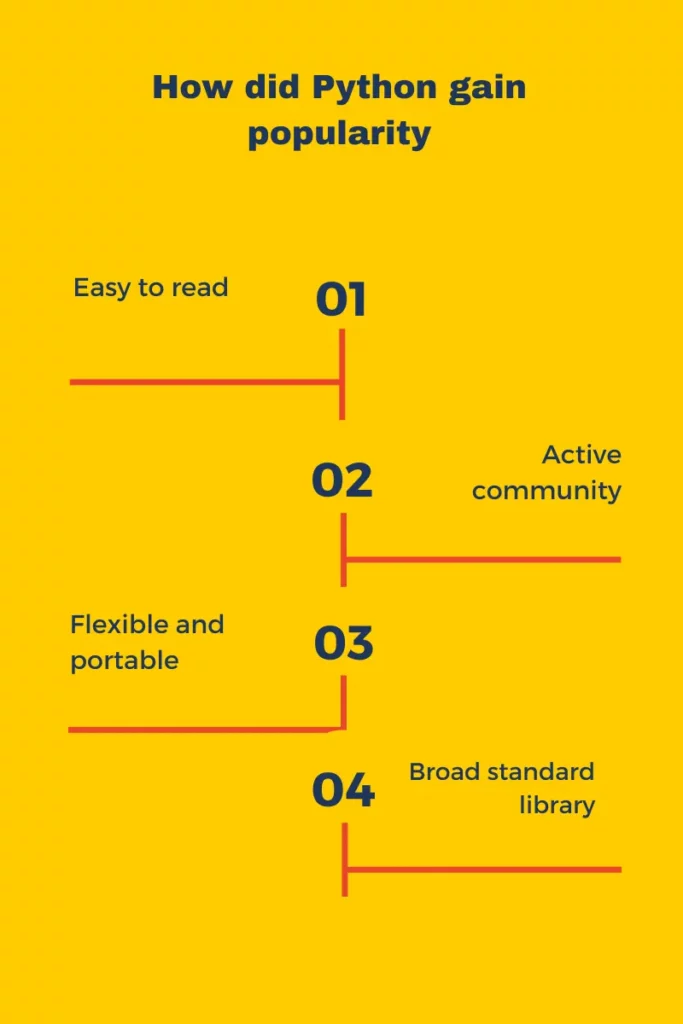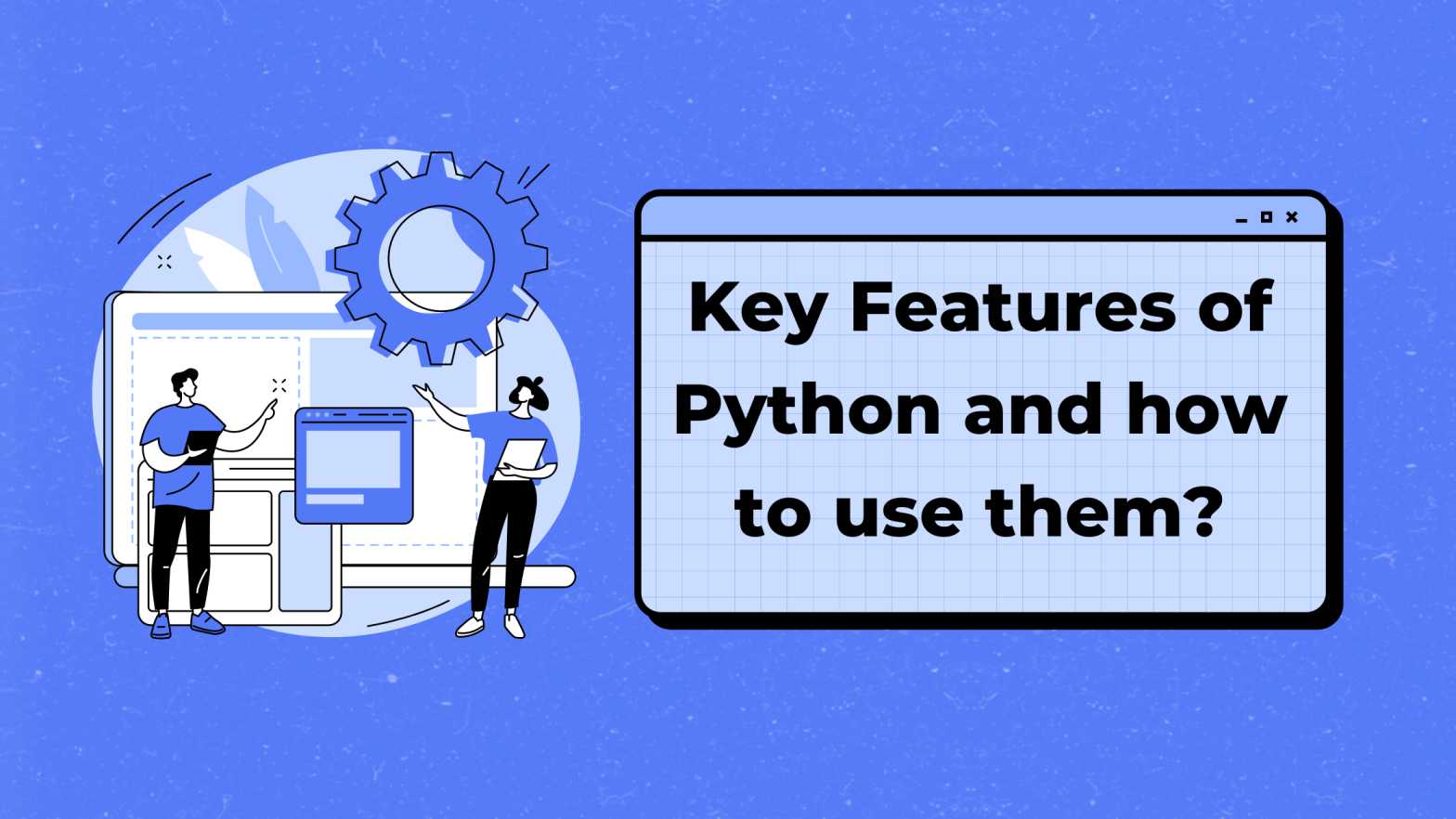Table of Contents
Last updated on July 24th, 2024 at 09:20 am
Python is a dynamic, high-level programming language. Developers across the globe continue to use Python for a wide variety of applications. This open-source programming language has gained popularity in the community due to its wide array of features and capabilities.
But what is Python? Python is one of the simplest yet most useful programming languages. A survey showed that 49.28% of developers across the globe use Python, making it third on the list of most used programming languages.
It is a general-purpose language used for creating various applications, including web development, data science, automation, etc. Today, if you want to make a career in data science, understanding the nooks and crannies of Python is very important.
In this blog, we will learn about the key features of Python.
What is Python?
Python can be defined as a high-level, open-source, object-oriented, general-purpose programming language. Does that sound like a lot? Let’s break it down.
- High level: Allows programmers to develop computer programs that are independent of the type of machine it is running on.
- Open source: The language is free and available for further improvements. Programmers can add a helpful feature or fix a bug, there are no restrictions.
- Object-oriented: An object is a data field having unique behavior and attributes. An object-oriented programming language is a model that organizes software design around objects.
- General-purpose: The programming language can be used on any kind of platform. It is not specialized for any kind of problem.
It is widely used in software development, web applications, machine learning, and data science. Python has gained popularity because it is easy and efficient and can run on many platforms.
For entry-level coders, Python is one of the best programming languages to start with. Its versatility and easy-to-interpret tools have made Python a beginner-friendly programming language.
How did Python gain popularity?
Python features and advantages make it a popular coding language. Even people who do not know coding have heard about Python. It started as a hobby project and soon turned into the successful giant that it is today. According to a survey, the size of the Python community in the world is 44.6%, making it third on the list.
Here are some reasons why Python continues to gain popularity:
- Easy to read: Python code uses English keywords. It has a simplified intuitive syntax that makes it easy to read. For people entering the world of programming, Python is easy to interpret. One can simply understand what the code is meant to do by looking at it.
- Active community: Unlike the English language, Python programming language is fairly new. Every programmer is trying to learn how to work around the language. Python has built a dedicated user community in the last thirty years of its running. This community has developers of all skill levels. Programmers have easy access to guides, documentation, tutorials, and more. Developers from the community also crowdsource their work to find effective solutions.
- Flexible and portable: Python is not domain-specific. Which means, it is not designed for certain applications only. Python can be used to develop nearly all kinds of applications in any field. Python is also portable. This means, unlike some languages which need to be modified to run on different platforms, Python doesn’t. It is a cross-platform language. The same code can be run on any operating system using a Python interpreter.
- Broad standard library: The Python library is available for anyone to access. This means that programmers don’t need to write code for every function. Built-in modules are available to help with issues that might come up during coding.

Advantages of Python programming
Python is a flexible, powerful, and easy-to-use computer language. It has gained a lot of popularity and is widely used for many reasons. Here are some Python features and advantages:
- Higher productivity: Python has a lot of uses. It is a simple language that allows programmers to focus on solving the issue. Rather than worrying about the syntax. For beginners, this is ideal cause they don’t need much time to learn about the syntax of the language. With Python, programmers can complete more assignments with less code.
- Supports multiple programming models: Python supports procedural, object-oriented, and functional programming. The object-oriented approach facilitated code modularity, reusability, and extensibility. This is done using the four pillars of OOPs – inheritance, abstraction, encapsulation, and polymorphism. Using functional programming, programmers can write clearer and bug-resistant codes.
- Test-driven development: With Python, one can easily do test-driven development (TDD). Programmers can easily write code and test it at the same time. Using the TDD approach, programmers can test cases before creating the source code.
- Frameworks and libraries: Python has frameworks and libraries for practically every application domain. For example, NumPy, a Python toolkit is used for altering multidimensional arrays along with performing high-level mathematical operations. Ggplot, Matplotlib, Plotly, and Seaborn are some of the graphics and visualisation Python libraries. Programmers who want to do web programming can use popular Python frameworks such as Bottle, Django, or Flask. These are just a few examples, there are several more offering various features.
- High-earning prospects: Software developers are needed in almost every industry. Python professionals are among some of the highest-paid developers. Companies are always on the lookout for well-trained Python professionals.
Check out the Python job salaries offered to freshers and experienced candidates.
Characteristics of Python
Now that we have learned the advantages of the languages, what are the key features of Python? Python offers a lot of features which makes it a popular programming language. Here are a few key features of Python:
- Interpreted language: Python by definition is an interpreted language. This means each line of code is executed separately by the Python interpreter. This makes the debugging process much easier. Furthermore, when Python code is executed, it is immediately translated to byte code. This makes execution simpler and runtime is saved in the long run.
- Cross-platform language: Python is a cross-platform language. This is one of the key features of Python. It can run on different operating systems such as Linux, Windows, and macOS without any alterations. This helps developers to write their code once and deploy it on various platforms. It is a great way of saving time and effort in application development. Cross-platform compatibility makes Python ideal for modern software development. With this, applications can reach a broader audience across various devices and operating systems.
- Dynamic language: Python is a dynamically typed language. This means the type of variable is determined during the runtime. In the case of statistically typed languages such as Java or C++, explicit type declarations are needed. However, Python does not need that. Python also allows variables to be bound to different objects at runtime. This helps in creating reusable codes and reduces code redundancy.
- Object-oriented and procedure-oriented: An object-oriented programming language focuses the code design around objects and data. Not on logic and function. On the other hand, a procedure-oriented language focuses more on functions. One of the key features of Python is that it supports both object-oriented and procedure-oriented programming.
- Read-Evaluate-Print Loop (REPL) Environment: Python offers are REPL environment or an interactive shell. It enables developers to experiment with code snippets easily. It also allows developers to execute their code and immediately see the output. This facilitates rapid experimentation and prototyping. REPL is one of the key features of Python plays a crucial role in development and debugging. In this way, developers can test code snippets, check results, and refine the code.
Importance of Python programming in different areas
Python programming has become a very important programming language and has a wide array of applications. Here are important Python programming applications:
Web development: Developers often use Python to build the back end of a website. It is used for sending data to and from servers, communicating with databases, ensuring security, and routing URLs. Some commonly used web development frameworks are Django and Flask.
- Game development: In the rapidly evolving gaming industry, Python programming has proved to be an exceptional choice for game development. Many games like Pirates of the Caribbean and Battlefield 2 are built using Python programming.
- Data analysis: Python has become the building block of data science. It permits data analysts and other professionals to perform complex statistical calculations, build ML algorithms, analyse and manipulate data, etc.
- Automation: It is one of the key features of Python for those who perform the same task repeatedly. Creating a code using the automated process of Python is called scripting. Programmers use automation to find errors across various files, perform simple math, and remove duplicates from data.
- Every-day tasks: Python isn’t only for data scientists and programmers. Non-programmers can also use Python to simplify their lives. Here are a few everyday tasks you can simplify using Python.
- Converting text files to spreadsheets
- Filling out online forms automatically
- Renaming large files
- Randomly allotting tasks to office or family members
Conclusion
From Google to Instagram to NASA – leading technology giants of the world are using Python. The language has gained a lot of popularity because of the key features of Python.
Python has a lot of applications in software development, web development, application development, etc. Data analysts use Python tools to create visual structures like pie charts, bar graphs, line graphs, etc. This makes their job much easier and hassle-free.
If you want to build a career in data science, learn from the industry experts at Imarticus. This six-month programme has been curated to help you become a pro data analyst.
Enrol with Imarticus today!
FAQ’s
Python was created in 1989 by Guido Van Rossum, a programmer from the Netherlands. It was initially started as a Christmastime hobby and later became the language that we know today.
Python has several libraries each offering a different function. It is one of the main characteristics of Python. Some of the popular Python libraries are:
Pandas
Matplotlib
NumPy
Keras
Many key features of Python are executed using Python frameworks. Some of the popular Python frameworks are:
Flask
Django
PyTorch
TurboGears
The average annual salary of a Python developer in India is INR 5.7 LPA.

